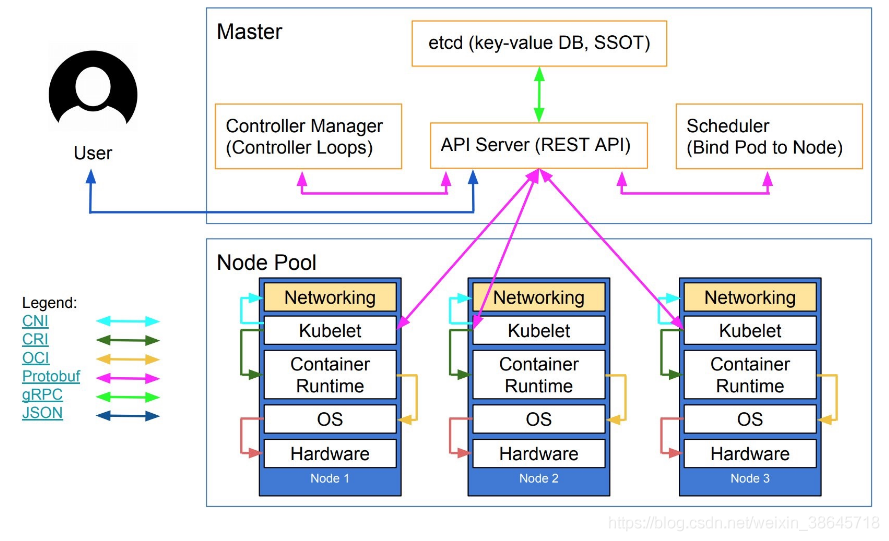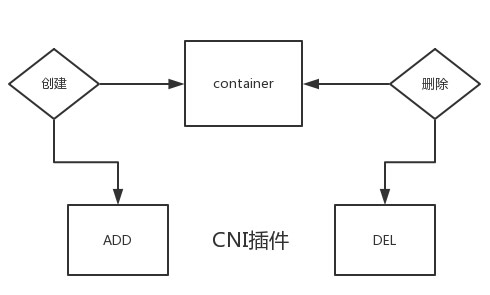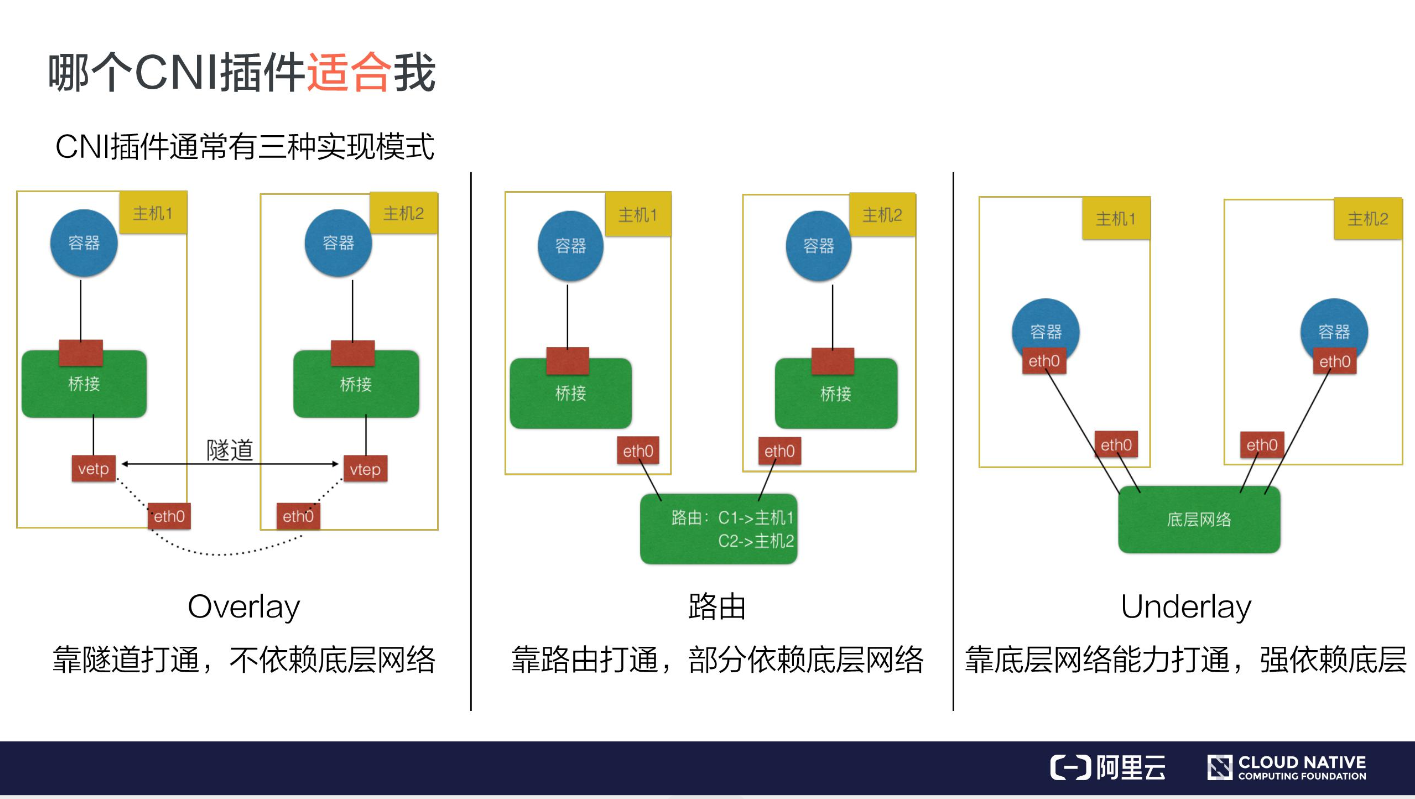K8S控制器介绍与使用
K8S逻辑架构图

Kubernetes主要由以下几个核心组件组成:
-
etcd保存了整个集群的状态;
-
apiserver提供了资源操作的唯一入口,并提供认证、授权、访问控制、API注册和发现等机制;
-
controller manager负责维护集群的状态,比如故障检测、自动扩展、滚动更新等;
-
scheduler负责资源的调度,按照预定的调度策略将Pod调度到相应的机器上;
-
kubelet负责维护容器的生命周期,同时也负责Volume(CVI)和网络(CNI)的管理;
-
Container runtime负责镜像管理以及Pod和容器的真正运行(CRI);
-
kube-proxy负责为Service提供cluster内部的服务发现和负载均衡;
除了核心组件,还有一些推荐的Add-ons: -
kube-dns负责为整个集群提供DNS服务
-
Ingress Controller为服务提供外网入口
-
Heapster提供资源监控
-
Dashboard提供GUI
-
Federation提供跨可用区的集群
-
Fluentd-elasticsearch提供集群日志采集、存储与查询
CNI( 容器网络接口,提供网络资源)
CNI是Container Network Interface的是一个标准的,通用的接口。 CNI用于连接容器管理系统和网络插件。CNI的工作是从容器管理系统处获取运行时信息,包括network namespace的路径,容器ID以及network interface name,再从容器网络的配置文件中加载网络配置信息,再将这些信息传递给对应的插件,由插件进行具体的网络配置工作,并将配置的结果再返回到容器管理系统中。
CNI插件是可执行文件,由被kubelet调用。启动kubelet --network-plugin=cni,–cni-conf-dir 指定networkconfig配置,默认路径是:/etc/cni/net.d,并且,–cni-bin-dir 指定plugin可执行文件路径,默认路径是:/opt/cni/bin;
CNI plugin 只需要通过 CNI 库实现两类方法, 一类事创建容器时调用, 一类是删除容器时调用.

CNI的接口中包括以下几个方法:
type CNI interface {
AddNetworkList(net *NetworkConfigList, rt *RuntimeConf) (types.Result, error)
DelNetworkList(net *NetworkConfigList, rt *RuntimeConf) error
AddNetwork(net *NetworkConfig, rt *RuntimeConf) (types.Result, error)
DelNetwork(net *NetworkConfig, rt *RuntimeConf) error
}
该接口只有四个方法,添加网络、删除网络、添加网络列表、删除网络列表。

Overlay 模式
Overlay指的是一种传统网络架构上叠加的虚拟化技术,底层有(NVGRE和VXLAN等技术),在的典型特征是容器独立于主机的 IP 段,这个 IP 段进行跨主机网络通信时是通过在主机之间创建隧道的方式,将整个容器网段的包全都封装成底层的物理网络中主机之间的包。该方式的好处在于它不依赖于底层网络;
扩展资料:http://www.h3c.com/cn/d_201501/852551_30008_0.htm
路由模式
中主机和容器也分属不同的网段,它与 Overlay 模式的主要区别在于它的跨主机通信是通过路由打通,无需在不同主机之间做一个隧道封包。但路由打通就需要部分依赖于底层网络,比如说要求底层网络有二层可达的一个能力;
Underlay
模式中容器和宿主机位于同一层网络,两者拥有相同的地位。容器之间网络的打通主要依靠于底层网络。因此该模式是强依赖于底层能力的。
k8s网络之Flannel网络 k8s网络之Calico网络 https://www.cnblogs.com/goldsunshine/p/10740928.html
原文链接:https://blog.csdn.net/valada/article/details/104786619
参考地址:https://blog.csdn.net/zhonglinzhang/article/details/82697524
https://zhuanlan.zhihu.com/p/33390023
https://blog.csdn.net/valada/article/details/104786619
CRI (容器运行时接口,提供计算资源)
容器运行时接口(Container Runtime Interface),用于解除K8S和容器的耦合性;
CRI中定义了容器和镜像的服务的接口
- RuntimeService:容器和Sandbox运行时管理
- ImageService:提供了从镜像仓库拉取、查看、和移除镜像的RPC。
cri-o:同时兼容OCI和CRI的容器运行时
cri-containerd:基于Containerd的Kubernetes CNI实现
rkt:由于CoreOS主推的用来跟docker抗衡的容器运行时
frakti:基于hypervisor的CRI
docker:kuberentes最初就开始支持的容器运行时,目前还没完全从kubelet中解耦,docker公司同时推广了OCI标准
clear-containers:由Intel推出的同时兼容OCI和CRI的容器运行时
kata-containers:符合OCI规范同时兼容CRI
在Kubernetes1.9中的CRI接口在api.proto中定义
// Runtime service defines the public APIs for remote container runtimes
service RuntimeService {
// Version returns the runtime name, runtime version, and runtime API version.
rpc Version(VersionRequest) returns (VersionResponse) {}
// RunPodSandbox creates and starts a pod-level sandbox. Runtimes must ensure
// the sandbox is in the ready state on success.
rpc RunPodSandbox(RunPodSandboxRequest) returns (RunPodSandboxResponse) {}
// StopPodSandbox stops any running process that is part of the sandbox and
// reclaims network resources (e.g., IP addresses) allocated to the sandbox.
// If there are any running containers in the sandbox, they must be forcibly
// terminated.
// This call is idempotent, and must not return an error if all relevant
// resources have already been reclaimed. kubelet will call StopPodSandbox
// at least once before calling RemovePodSandbox. It will also attempt to
// reclaim resources eagerly, as soon as a sandbox is not needed. Hence,
// multiple StopPodSandbox calls are expected.
rpc StopPodSandbox(StopPodSandboxRequest) returns (StopPodSandboxResponse) {}
// RemovePodSandbox removes the sandbox. If there are any running containers
// in the sandbox, they must be forcibly terminated and removed.
// This call is idempotent, and must not return an error if the sandbox has
// already been removed.
rpc RemovePodSandbox(RemovePodSandboxRequest) returns (RemovePodSandboxResponse) {}
// PodSandboxStatus returns the status of the PodSandbox. If the PodSandbox is not
// present, returns an error.
rpc PodSandboxStatus(PodSandboxStatusRequest) returns (PodSandboxStatusResponse) {}
// ListPodSandbox returns a list of PodSandboxes.
rpc ListPodSandbox(ListPodSandboxRequest) returns (ListPodSandboxResponse) {}
// CreateContainer creates a new container in specified PodSandbox
rpc CreateContainer(CreateContainerRequest) returns (CreateContainerResponse) {}
// StartContainer starts the container.
rpc StartContainer(StartContainerRequest) returns (StartContainerResponse) {}
// StopContainer stops a running container with a grace period (i.e., timeout).
// This call is idempotent, and must not return an error if the container has
// already been stopped.
// TODO: what must the runtime do after the grace period is reached?
rpc StopContainer(StopContainerRequest) returns (StopContainerResponse) {}
// RemoveContainer removes the container. If the container is running, the
// container must be forcibly removed.
// This call is idempotent, and must not return an error if the container has
// already been removed.
rpc RemoveContainer(RemoveContainerRequest) returns (RemoveContainerResponse) {}
// ListContainers lists all containers by filters.
rpc ListContainers(ListContainersRequest) returns (ListContainersResponse) {}
// ContainerStatus returns status of the container. If the container is not
// present, returns an error.
rpc ContainerStatus(ContainerStatusRequest) returns (ContainerStatusResponse) {}
// UpdateContainerResources updates ContainerConfig of the container.
rpc UpdateContainerResources(UpdateContainerResourcesRequest) returns (UpdateContainerResourcesResponse) {}
// ExecSync runs a command in a container synchronously.
rpc ExecSync(ExecSyncRequest) returns (ExecSyncResponse) {}
// Exec prepares a streaming endpoint to execute a command in the container.
rpc Exec(ExecRequest) returns (ExecResponse) {}
// Attach prepares a streaming endpoint to attach to a running container.
rpc Attach(AttachRequest) returns (AttachResponse) {}
// PortForward prepares a streaming endpoint to forward ports from a PodSandbox.
rpc PortForward(PortForwardRequest) returns (PortForwardResponse) {}
// ContainerStats returns stats of the container. If the container does not
// exist, the call returns an error.
rpc ContainerStats(ContainerStatsRequest) returns (ContainerStatsResponse) {}
// ListContainerStats returns stats of all running containers.
rpc ListContainerStats(ListContainerStatsRequest) returns (ListContainerStatsResponse) {}
// UpdateRuntimeConfig updates the runtime configuration based on the given request.
rpc UpdateRuntimeConfig(UpdateRuntimeConfigRequest) returns (UpdateRuntimeConfigResponse) {}
// Status returns the status of the runtime.
rpc Status(StatusRequest) returns (StatusResponse) {}
}
// ImageService defines the public APIs for managing images.
service ImageService {
// ListImages lists existing images.
rpc ListImages(ListImagesRequest) returns (ListImagesResponse) {}
// ImageStatus returns the status of the image. If the image is not
// present, returns a response with ImageStatusResponse.Image set to
// nil.
rpc ImageStatus(ImageStatusRequest) returns (ImageStatusResponse) {}
// PullImage pulls an image with authentication config.
rpc PullImage(PullImageRequest) returns (PullImageResponse) {}
// RemoveImage removes the image.
// This call is idempotent, and must not return an error if the image has
// already been removed.
rpc RemoveImage(RemoveImageRequest) returns (RemoveImageResponse) {}
// ImageFSInfo returns information of the filesystem that is used to store images.
rpc ImageFsInfo(ImageFsInfoRequest) returns (ImageFsInfoResponse) {}
CSI:容器存储接口,提供存储资源 CSI 代表容器存储接口,CSI 试图建立一个行业标准接口的规范,借助 CSI 容器编排系统(CO)可以将任意存储系统暴露给自己的容器工作负载。
csi 卷类型是一种 in-tree(即跟其它存储插件在同一个代码路径下,随 Kubernetes 的代码同时编译的) 的 CSI 卷插件,用于 Pod 与在同一节点上运行的外部 CSI 卷驱动程序交互。部署 CSI 兼容卷驱动后,用户可以使用 csi 作为卷类型来挂载驱动提供的存储。
CSI 持久化卷支持是在 Kubernetes v1.9 中引入的,作为一个 alpha 特性,必须由集群管理员明确启用。换句话说,集群管理员需要在 apiserver、controller-manager 和 kubelet 组件的 “–feature-gates =” 标志中加上 “CSIPersistentVolume = true”。
CSI 持久化卷具有以下字段可供用户指定:
-
driver:一个字符串值,指定要使用的卷驱动程序的名称。必须少于 63 个字符,并以一个字符开头。驱动程序名称可以包含 “.”、“-”、“_” 或数字。
-
volumeHandle:一个字符串值,唯一标识从 CSI 卷插件的 CreateVolume 调用返回的卷名。随后在卷驱动程序的所有后续调用中使用卷句柄来引用该卷。
-
readOnly:一个可选的布尔值,指示卷是否被发布为只读。默认是 false。
对象管理与配置格式
K8S以对象的形式描述各种资源,多数对象都可以在 yaml 文件中作为一种 API 类型来配置
| 类别 | 名称 |
|---|---|
| 资源对象 | Pod、ReplicaSet、ReplicationController、Deployment、StatefulSet、DaemonSet、Job、CronJob、HorizontalPodAutoscaling、Node、Namespace、Service、Ingress、Label、CustomResourceDefinition |
| 存储对象 | Volume、PersistentVolume、Secret、ConfigMap |
| 策略对象 | SecurityContext、ResourceQuota、LimitRange |
| 身份对象 | ServiceAccount、Role、ClusterRole |
每个 Kubernetes 对象包含两个嵌套的对象字段,它们负责管理对象的配置:对象 spec 和 对象 status。
- spec 必须提供,它描述了对象的 期望状态—— 希望对象所具有的特征。
- status 描述了对象的 实际状态,它是由 Kubernetes 系统提供和更新。
在任何时刻,Kubernetes 控制平面一直处于活跃状态,管理着对象的实际状态以与我们所期望的状态相匹配
必需字段
在想要创建的 Kubernetes 对象对应的 .yaml 文件中,需要配置如下的字段:
-
apiVersion - 创建该对象所使用的 Kubernetes API 的版本
-
kind - 想要创建的对象的类型
-
metadata - 帮助识别对象唯一性的数据,包括一个 name 字符串、UID 和可选的 namespace
示例
apiVersion: apps/v1beta1 #指定k8sapi版本
kind: Deployment 指定控制器
metadata: #标识一下唯一性
name: nginx-deployment
spec: #开始描述对象的期望数量
replicas: 3 #期望的副本数量
minReadySeconds: 0 #指定新的pod就绪多久后才认为这个pod正常运行了
template: # 指定一下模板(PodTemplateSpec),k8s根据指定的模板创建pod
metadata: #指定模板唯一标识
labels:
app: nginx
spec:
containers: #指定一下容器
- name: nginx #指定名称
image: nginx:1.7.9 指定镜像
ports: #指定端口
- containerPort: 80
YAML配置api参考地址:https://kubernetes.io/docs/reference/kubernetes-api/workload-resources/pod-v1/#PodSpec
ReplicationController 和 ReplicaSet
ReplicationController 用来确保容器应用的副本数始终保持在用户定义的副本数,即如果有容器异常退出,会自动创建新的 Pod 来替代;而如果异常多出来的容器也会自动回收。
在新版本的 Kubernetes 中建议使用 ReplicaSet 来取代 ReplicationController。ReplicaSet 跟 ReplicationController 没有本质的不同,只是名字不一样,并且 ReplicaSet 支持集合式的 selector。
虽然 ReplicaSet 可以独立使用,但一般还是建议使用 Deployment 来自动管理 ReplicaSet。
配置示例
apiVersion: extensions/v1beta1 #指定k8s版本
kind: ReplicaSet 指定对象
metadata:
name: frontend 指定唯一标识
labels: #设定该对象的标签
group: a0000
number: a00001
spec: ##描述配置信息
replicas: 3 #副本数量
#标签选择器
#ReplicaSet和ReplicationController的区别,只有ReplicaSet才有
selector:
#matchExpressions 的一个元素,其键字段为“key”,运算符为“In”,values 数组仅包含“value”
matchLabels:
group: a0000
#matchExpressions 是标签选择器要求的列表,内部是and运算,可以写很多个
matchExpressions:
- {key: tier, operator: In, values: [frontend]}
template: #指定模板
metadata: #指定唯一标识
labels:
app: guestbook
tier: frontend
spec:
containers: ##指定多个容器
- name: php-redis #指定容器名称
image: gcr.io/google_samples/gb-frontend:v3 #指定镜像
resources:
requests: #需求限制
cpu: 100m #指定100毫核
memory: 100Mi
limits: #最大限制,需要大于等于requests配置
cpu: 100m
memory: 100Mi
env:
- name: GET_HOSTS_FROM
value: dns
# If your cluster config does not include a dns service, then to
# instead access environment variables to find service host
# info, comment out the 'value: dns' line above, and uncomment the
# line below.
# value: env
ports:
- containerPort: 80
K8s的资源:
- CPU
2核2线程的CPU,可被系统识别为4个逻辑CPU,在K8s中对CPU的分配限制是对逻辑CPU做分片限制的。也就是说分配给容器一个CPU,实际是分配一个逻辑CPU。
而且1个逻辑CPU还可被单独划分子单位,即 1个逻辑CPU,还可被划分为1000个millicore(毫核)
豪核:可简单理解为将CPU的时间片做逻辑分割,每一段时间片就是一个豪核心。
所以:500m 就是500豪核心,即0.5个逻辑CPU.
- 内存:
K,M,G,T,P,E #通常这些单位是以1000为换算标准的。
Ki, Mi, Gi, Ti, Pi, Ei #这些通常是以1024为换算标准的。

Deployment
Deployment 为 Pod 和 ReplicaSet 提供了一个声明式定义(declarative)方法,用来替代以前的 ReplicationController 来方便的管理应用。典型的应用场景包括:
-
定义 Deployment 来创建 Pod 和 ReplicaSet
-
滚动升级和回滚应用
-
扩容和缩容
-
暂停和继续 Deployment
注:Deployment是一种为无状态服务而设计
配置示例
apiVersion: extensions/v1beta1
kind: Deployment
metadata:
name: nginx-deployment
spec:
replicas: 3
template:
metadata:
labels:
app: nginx
spec:
containers:
- name: nginx
image: nginx:1.7.9
ports:
- containerPort: 80
- 执行扩容:
#手动扩容
kubectl scale deployment nginx-deployment --replicas 10
#设置自动扩展
kubectl autoscale deployment nginx-deployment --min=10 --max=15 --cpu-percent=80
- 更新镜像
kubectl set image deployment/nginx-deployment nginx=nginx:1.9.1
- 回滚
kubectl rollout undo deployment/nginx-deployment
StatefulSet
StatefulSet 作为 Controller 为 Pod 提供唯一的标识。它可以保证部署和 scale 的顺序,是为了解决有状态服务的问题
StatefulSet 适用于有以下某个或多个需求的应用:
-
稳定,唯一的网络标志。
-
稳定,持久化存储。
-
有序,优雅地部署和 scale。
-
有序,优雅地删除和终止。
-
有序,自动的滚动升级。
StatefulSet中每个Pod的DNS格式为
statefulSetName-{0…N-1}.serviceName.namespace.svc.cluster.local
其中
-
serviceName为Headless Service的名字
-
0…N-1为Pod所在的序号,从0开始到N-1
-
statefulSetName为StatefulSet的名字
-
namespace为服务所在的namespace,Headless Servic和StatefulSet必须在相同的namespace
-
.cluster.local为Cluster Domain
什么是 DaemonSet?
DaemonSet 确保全部(或者一些)Node 上运行一个 Pod 的副本。当有 Node 加入集群时,也会为他们新增一个 Pod 。当有 Node 从集群移除时,这些 Pod 也会被回收。删除 DaemonSet 将会删除它创建的所有 Pod。
使用 DaemonSet 的一些典型用法:
-
运行集群存储 daemon,例如在每个 Node 上运行 glusterd、ceph。
-
在每个 Node 上运行日志收集 daemon,例如fluentd、logstash。
-
在每个 Node 上运行监控 daemon,例如 Prometheus Node Exporter、collectd、Datadog 代理、New Relic 代理,或 Ganglia gmond。
一个简单的用法是,在所有的 Node 上都存在一个 DaemonSet,将被作为每种类型的 daemon 使用。 一个稍微复杂的用法可能是,对单独的每种类型的 daemon 使用多个 DaemonSet,但具有不同的标志,和/或对不同硬件类型具有不同的内存、CPU要求。
Job
Job负责批处理任务,即仅执行一次的任务,它保证批处理任务的一个或多个Pod成功结束。
Job Spec格式
-
spec.template格式同Pod
-
RestartPolicy仅支持Never或OnFailure
-
单个Pod时,默认Pod成功运行后Job即结束
-
.spec.completions标志Job结束需要成功运行的Pod个数,默认为1
-
.spec.parallelism标志并行运行的Pod的个数,默认为1
-
spec.activeDeadlineSeconds标志失败Pod的重试最大时间,超过这个时间不会继续重试
一个简单的例子:
apiVersion: batch/v1
kind: Job
metadata:
name: pi
spec:
template:
metadata:
name: pi
spec:
containers:
- name: pi
image: perl
command: ["perl", "-Mbignum=bpi", "-wle", "print bpi(2000)"]
restartPolicy: Never
$ kubectl create -f ./job.yaml
job "pi" created
$ pods=$(kubectl get pods --selector=job-name=pi --output=jsonpath={.items..metadata.name})
$ kubectl logs $pods -c pi
3.141592653589793238462643383279502...
CronJob
Cron Job 管理基于时间的 Job,即:
- 在给定时间点只运行一次
- 周期性地在给定时间点运行
一个 CronJob 对象类似于 crontab (cron table)文件中的一行。它根据指定的预定计划周期性地运行一个 Job,格式可以参考 Cron 。
CronJob Spec
-
.spec.schedule:调度,必需字段,指定任务运行周期,格式同 Cron
-
.spec.jobTemplate:Job 模板,必需字段,指定需要运行的任务,格式同 Job
-
.spec.startingDeadlineSeconds :启动 Job 的期限(秒级别),该字段是可选的。如果因为任何原因而错过了被调度的时间,那么错过执行时间的 Job 将被认为是失败的。如果没有指定,则没有期限
-
.spec.concurrencyPolicy:并发策略,该字段也是可选的。它指定了如何处理被 Cron Job 创建的 Job 的并发执行。只允许指定下面策略中的一种:注意,当前策略只能应用于同一个 Cron Job 创建的 Job。如果存在多个 Cron Job,它们创建的 Job 之间总是允许并发运行。
-
- Allow(默认):允许并发运行 Job
- Forbid:禁止并发运行,如果前一个还没有完成,则直接跳过下一个
-
- Replace:取消当前正在运行的 Job,用一个新的来替换
-
.spec.suspend :挂起,该字段也是可选的。如果设置为 true,后续所有执行都会被挂起。它对已经开始执行的 Job 不起作用。默认值为 false。
-
.spec.successfulJobsHistoryLimit 和 .spec.failedJobsHistoryLimit :历史限制,是可选的字段。它们指定了可以保留多少完成和失败的 Job。默认情况下,它们分别设置为 3 和 1。设置限制的值为 0,相关类型的 Job 完成后将不会被保留。
apiVersion: batch/v1beta1
kind: CronJob
metadata:
name: hello
spec:
schedule: "*/1 * * * *"
jobTemplate:
spec:
template:
spec:
containers:
- name: hello
image: busybox
args:
- /bin/sh
- -c
- date; echo Hello from the Kubernetes cluster
restartPolicy: OnFailure
启动删除
kubectl run hello --schedule="*/1 * * * *" --restart=OnFailure --image=busybox -- /bin/sh -c "date; echo Hello from the Kubernetes cluster"
kubectl delete cronjob hello





















 2721
2721











 被折叠的 条评论
为什么被折叠?
被折叠的 条评论
为什么被折叠?








